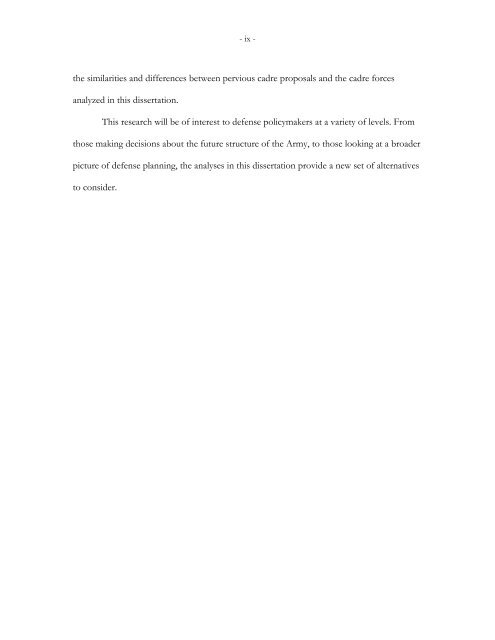Considering a Cadre Augmented Army - RAND Corporation
Considering a Cadre Augmented Army - RAND Corporation Considering a Cadre Augmented Army - RAND Corporation
- viii - The budgetary analysis of a cadre augmented force shows that cadre units can offer annual cost savings measured in billions of dollars. This analysis explores various ways to integrate cadre into the total force. No matter which way cadre units are integrated, this paper shows that a cadre augmented force can significantly reduce annual defense costs. However, these cost savings are accompanied by an increase in military risk. This paper presents the tradeoffs between cost and military risk for the reader to consider. The operational analysis discusses how cadre units could work in practice. This analysis focuses on how cadre units could be structured, organized, and equipped in peacetime and activated, filled out, trained, and demobilized during wartime. The most important issue discussed in this chapter is the ability of the army to expand during wartime to fill out cadre units. We find that increased recruiting alone cannot fill out a cadre force that mobilizes at a rate of more than one combat unit per year. Therefore, we explore the possibility of activating members of the Individual Ready Reserve (IRR) or offering bonuses to Reserve Component (RC) personnel to serve in cadre units. Both of these approaches have disadvantages; they both require significant changes to army personnel policies and can reduce the cost savings from cadre. The ability to fill out cadre units with junior personnel in wartime appears to be the major barrier to implementing a cadre augmented force. The final analysis in this dissertation is a historical analysis of cadre forces. Cadre forces have been proposed many times throughout the history of the U.S. Army. The historical analysis shows that cadre units have been proposed in the past for two main reasons, either because there was a change in the threat perceived by the Army or because there was a change in the perceived effectiveness of the reserves. This analysis also discusses
- ix - the similarities and differences between pervious cadre proposals and the cadre forces analyzed in this dissertation. This research will be of interest to defense policymakers at a variety of levels. From those making decisions about the future structure of the Army, to those looking at a broader picture of defense planning, the analyses in this dissertation provide a new set of alternatives to consider.
- Page 1 and 2: THE ARTS CHILD POLICY CIVIL JUSTICE
- Page 3 and 4: Considering a Cadre Augmented Army
- Page 5: - iii - PREFACE This dissertation e
- Page 9: - vii - SUMMARY This dissertation c
- Page 15 and 16: - xiii - ACRONYMS Symbol AC AIT ARF
- Page 17 and 18: -1- Introduction Introduction This
- Page 19 and 20: -3- Introduction ability to rotate
- Page 21 and 22: -5- Introduction In a force designe
- Page 23 and 24: -7- Introduction increasing militar
- Page 25 and 26: -9- Introduction peacetime have bee
- Page 27: -11- Introduction forces. This is i
- Page 30 and 31: -14- A Budgetary Analysis of Cadre
- Page 32 and 33: -16- A Budgetary Analysis of Cadre
- Page 34 and 35: -18- A Budgetary Analysis of Cadre
- Page 37 and 38: -21- A Budgetary Analysis of Cadre
- Page 39 and 40: -23- A Budgetary Analysis of Cadre
- Page 41 and 42: -25- A Budgetary Analysis of Cadre
- Page 43 and 44: -27- A Budgetary Analysis of Cadre
- Page 45 and 46: -29- A Budgetary Analysis of Cadre
- Page 47 and 48: -31- A Budgetary Analysis of Cadre
- Page 49 and 50: -33- A Budgetary Analysis of Cadre
- Page 51 and 52: -35- A Budgetary Analysis of Cadre
- Page 53 and 54: -37- A Budgetary Analysis of Cadre
- Page 55 and 56: -39- A Budgetary Analysis of Cadre
- Page 57 and 58: -41- A Budgetary Analysis of Cadre
- Page 59 and 60: -43- A Budgetary Analysis of Cadre
- ix -<br />
the similarities and differences between pervious cadre proposals and the cadre forces<br />
analyzed in this dissertation.<br />
This research will be of interest to defense policymakers at a variety of levels. From<br />
those making decisions about the future structure of the <strong>Army</strong>, to those looking at a broader<br />
picture of defense planning, the analyses in this dissertation provide a new set of alternatives<br />
to consider.



